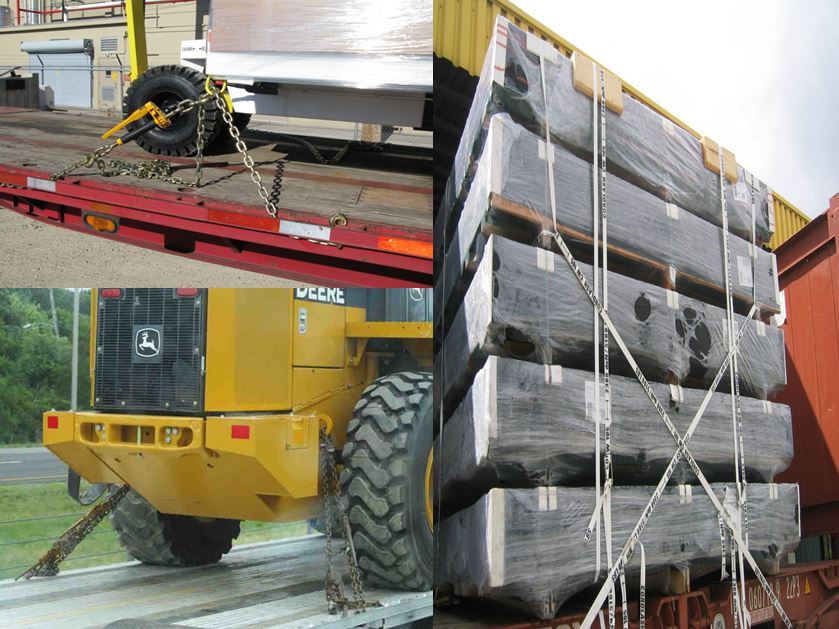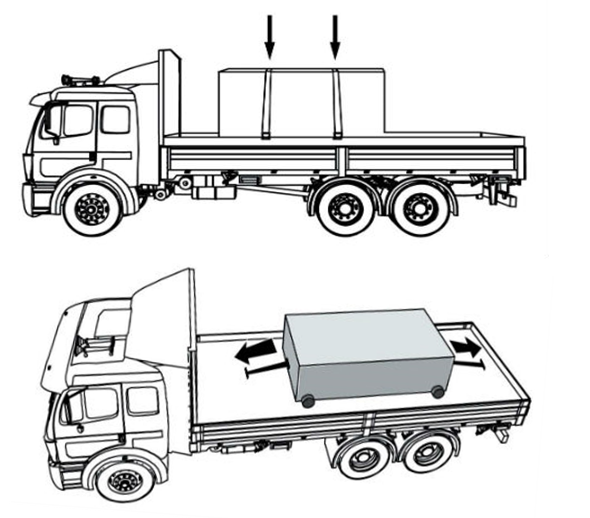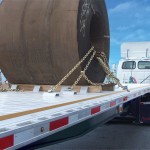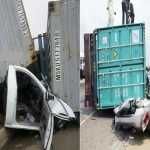
There are three standard ways in which cargo of all categories can be transported:
Condition 1: Cargo is fully contained by structures of adequate strength.
- Cargo cannot shift or tip
- Cargo is restrained against horizontal movement by vehicle structure or by other cargo. Horizontal movement includes forward, rearward, and side to side.
Note: If the cargo is contained in a sided vehicle, the vehicle structure MUST be strong enough to withstand the forces described earlier (Please read “Principle of Cargo Securement“)
- Forward force: 0.8 g (80%)
- Rearward force: 0.5.g (50%)
- Sideways force: 0.5 g (50%)
Condition 2: Cargo is immobilized by structures of adequate strength or a combination of structure, blocking, and bracing to prevent shifting or tipping.
Condition 3: To prevent shifting or tipping, cargo is immobilized or secured on or within a vehicle by tiedowns along with:
- Blocking.
- Bracing.
- Friction mats.
- Other cargo.
- Void fillers
- Combination of these.
Tiedown Explained
A tiedown is a combination of securing devices that forms an assembly that attaches cargo to, or restrains cargo on a vehicle and is attached to anchor point(s). Some tiedowns are attached to the cargo and provide direct resistance to restrain the cargo from movement.
Some tiedowns pass over or through the cargo. Each tiedown must be attached and secured so that it does not become loose or unfastened, open, or release during transit. They create a downward force that increases the effect of friction between the cargo and the deck. This friction restrains the cargo. A tiedown must be designed, constructed, and maintained so that the driver can easily tighten it should the need arise during journeys.
As stated for vehicle structure, all components of a tiedown must be in proper working order. No knots or obvious damage, no distress, no weakened parts and no weakened sections.
In some cargo where the likelihood of a tiedown being cut or torn when touching an article of cargo is clearly evident, there may be a need to brace the point of contact with an ‘Edge Protection’. The edge protection itself must also be strong enough to resist crushing, cutting, and abrasion.
Restraining the cargo correctly: How many tiedowns are required?
If cargo is not prevented from forward movement (for example, by the headboard, bulkhead, other cargo, or tiedown attached to the cargo), it is recommended that you secure your cargo according to the following requirements:2 tiedown for every 3.04 m (Approx. 10 ft.), or part thereof.
When cargo is prevented from forward movement (for example, by the headboard, bulkhead, other cargo, or tiedown), then the cargo can be secured according to the standard of: 1 tiedown for every 3.04 m (10 ft), or part thereof.
However, in a cargo comprising several numbers of small packaged articles such as 50kg bags of cement or flour or parboiled rice loaded on a flatbed, more tiedowns may be required than the aforestated. The most important consideration should be the effective securement of the cargo.
Note: A vehicle transporting one or more articles of cargo such as, but not limited to, machinery or fabricated structural items (e.g., steel or concrete beams, crane booms, girders, and trusses, etc.) which, because of their design, size, shape, or weight, must be fastened by special methods.
How should tiedowns be attached?
Tiedowns can be used in two ways:
- Attached to the cargo
- Tiedowns attached to the vehicle and attached to the cargo
- Tiedowns attached to the vehicle, pass through or around an article of cargo, and then are attached to the vehicle again.
- Pass over the cargo
- Tiedowns attached to the vehicle, passed over the cargo, and then attached to the vehicle again.
Tiedown placement
- Place the tiedown as close as possible to the spacer.
- Position the tiedowns as symmetrically as possible over the length of the article.
- Position the tiedowns to preserve the integrity of the article.
Tiedowns attached to the cargo
- Tiedowns attached to the cargo work by counteracting the forces acting on the cargo.
- The angle where the tiedown attaches to the vehicle should be shallow, not deep (ideally less than 45).
- To counteract forward movement, attach the tiedown so it pulls the cargo toward the rear of the vehicle.
- To counteract rearward movement, attach the tiedown so it pulls the cargo toward the front of the vehicle.
- To counteract movement to one side, attach the tiedown so it pulls the cargo toward the opposite side of the vehicle.
- To counteract upward movement, attach tiedowns to opposing sides of the cargo so they pull the cargo down.
Tiedowns that pass over the cargo
- Tiedowns that pass over the cargo work by increasing the effective weight of the cargo (make the cargo seem heavier). This increases the pressure of the cargo on the deck and keeps the cargo from shifting.
- Tension these tiedowns to as high an initial tension as possible.
- The steeper the tiedown angle, the less shifting (ideally more than 45).
What should you use in low-friction situations?
When there is low friction between the cargo and the deck (for example ice, sand, gravel and oil):
- Use tiedowns attached to the cargo.
- Use a means to improve the friction such as friction mats or tiedown that pass over the cargo.
- Use blocking and tiedowns.
Determining the adequacy of a Tiedown Device: Working Load Limit (WLL)
The Working Load Limit is the maximum load that may be applied to a component of a cargo securement system during normal service. Every tiedown device must have its WLL clearly stated.
The WLL is usually assigned by the component manufacturer. The WLL for a tiedown is the lowest WLL of any of its parts or the WLL of the anchor points it is attached to, whichever is less. Every device contributes to the WLL of the securement system.
The minimum WLL requirement for the securement system is 50%. The WLL of all components used to block cargo from forward movement must be 50% (or more) of the weight of the article being blocked. More tiedown capacity should be used if you need to secure an article against any movement.
Aggregate Working Load Limit is the sum of the working load limits of each device used to secure an article on a vehicle.
The aggregate working load limit of any securement system must be at least 50% of the weight of the cargo being secured.







